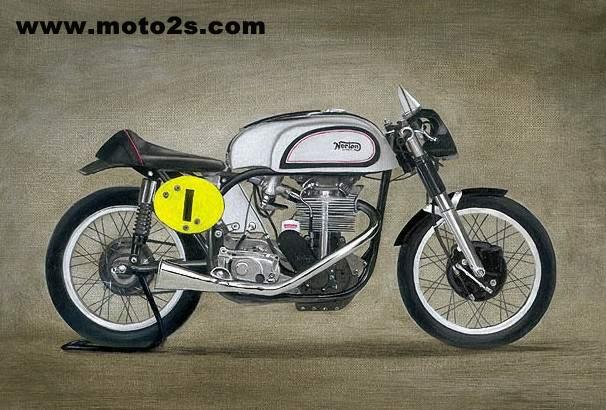Manx Norton
Manx Norton
1961 NORTON "MANX". Although eleven years separated the 1961 model "Manx" Norton from the first "Featherbed" type made in 1950, the basic design was almost unchanged except in detail.Instead of being bolted on, the rear sub-frame was welded to the main frame, a modification introduced in 1952, and the fancy tail fairing used in 1950 lasted only a year. But the basic frame pattern was unchanged. It is interesting to note that in this period the entire range of Norton roadster models of over 350 c.c. had been redesigned to incorporate the all-welded racing-style frame, an excellent example of racing improving the breed. The frame was probably cheaper to make than the old lug-and-tube type. In the intervening period the engine, which had been restyled in 1950 to be slim enough to fit the frame, underwent several major changes, the most noticeable being a much bigger bore, and consequently shorter stroke, which enabled high revs to be maintained without undue stress. The Norton factory was absorbed into the A.M.C. group in the mid-fifties and a change of gearbox was made on the "Manx" to utilize the same internals as the racers from Woolwich, so standardizing production and spares.
When it comes to vintage racing, few bikes are more iconic than the Manx Norton.
The Norton company has always applied the term "Manx" to the racing motorcycles that it produces in limited quantity for the open market. The name refers to the Isle of Man, where the Tourist Trophy is run. This annual race attracts the finest British racers, who compete on racing motorcycles that have been derived from production models are are available on the open market. Norton built its first Manx (although it was called an International at the time) in 1932. Derived from the Grand Prix, the motorcycle was the work of Arthur Carrol and Joe Craig. The tuning and modification of the Internationals was left to the customers, who proved to be up to the job. Meanwhile the racing department of the company continued to modernize the official models, which were transformed rapidly in those years to meet the tough competition provided by the motorcycles and racers of Rudge, Velocette, and Sunbeam in Britain, and Bianchi, Guzzi, and Moto-sacoche on the Continent. Between 1936 and 1938 the bore and stroke of the Grand Prix 500 were changed twice and a double overhead camshaft distribution was installed for the first time. Before racing was halted by World War II, the official Norton 500 boasted a power of 50 h.p. No other single-cylinder engine of that class could generate more horsepower, but its power was not enough to discourage the Italian and German makers of multi-cylinder models. Norton managed to hold its own, especially on mixed circuits, where its weight-power ratio helped racers. The Norton company was fortunate to have such fine racers as Jimmy Guthrie and Harold Daniell, two of the greatest champions of the time, and new racers were continually appearing on the scene. The first Norton motorcycles to reappear in racing in 1946 were old models that had been jealously guarded by their owners. Throughout Europe most of the racers who won improvised races had old SOHC Nortons, and the official Norton team reappeared with prewar DOHC motorcycles. Indeed, with the prohibition of superchargers it almost looked as if the single-cylinder might rule the roost, or at least have a temporary advantage over the four-cylinder Gilera, the two-cylinder BMW, and the two-stroke DKW. In reality, after losing the 1949 world championship to the two-cylinder AJS Porcupine in the 500 class and to the single-cylinder Velocette in the 350 class, Norton had to struggle in the following years to defend the slight margin that its racers had succeeded in winning for it. From 1951 on, the chief factor in Norton wins was its innovative Featherbed chassis, which was designed for Norton by the McCandless brothers. With this chassis Norton could outrace any motorcycle of equal power, especially on difficult tracks. The Norton Grand Prix won the world championship in 1950 (500 class), 1951 (350 and 500), and 1952 (350). These were not easy wins, and much credit was due to the fantastic skill of Geoffrey Duke, for whom the single-cylinder was perfectly suited. In 1949 the Norton International had become the Manx. That was the year the old SOHC system was replaced by a DOHC one. In 1952 the Manx was given a squared-off engine. In 1954, after Italian multi-cylinder motorcycles had outraced the Norton (despite the valiant efforts of Ray Amm), the company decided that as of 1955 only Manx models would be entered in races. Beginning in 1955 private racers throughout the world also defended Norton's colors with honor. Tuned by specialists, the final version of the Norton Manx 500 was considerably more powerful than the Grand Prix model from which it had been derived. And for some time to come it was a real threat to the most advanced motorcycles that entered the Tourist Trophy. |


